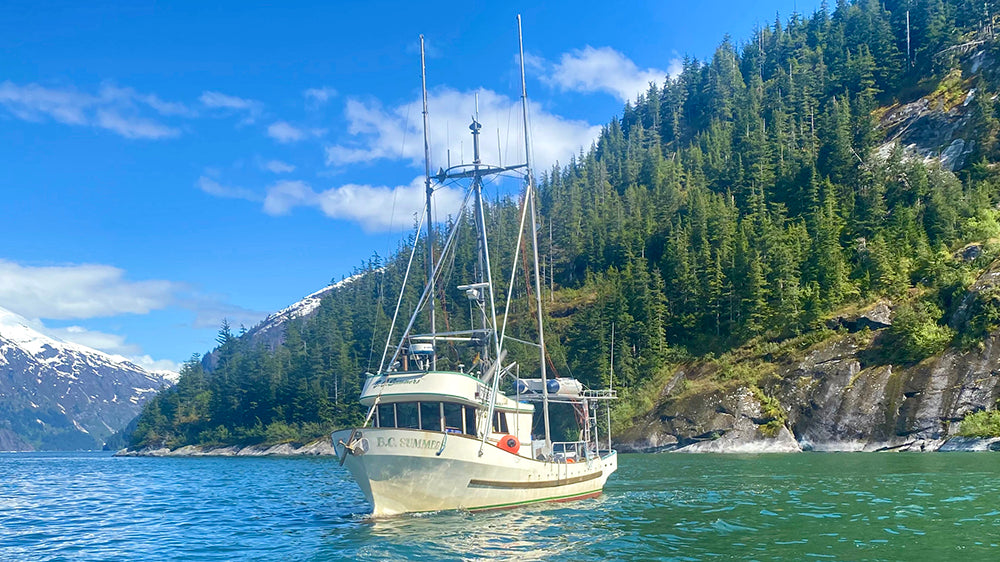In the United States, wild-caught fish are managed under a system of enforced environmentally responsible practices. Wild-capture fisheries are conducted under science-based management plans developed by regional fishery management councils and use the best scientific information available.
The wild-caught fish are taken from the water using nets, hand-lines, divers, or pots, allowing them to thrive in their natural environment. Farm-raised fish are raised in large tanks and given synthetic foods and additives to help them grow bigger, and adjust color to try and look more like wild fish.
Adding wild-caught sustainable seafood to your diet is the best way to improve heart health, boost brain function, and decrease inflammation. It is the most environmentally efficient source of protein on the planet, and comes with less of a carcinogen risk than farm-raised fish.
Alaskan King Salmon
According to the Environmental Defense Fund, Alaskan King Salmon is one of the safest sustainable seafood options and can be safely consumed several times a week compared to farmed salmon that can only be consumed once a month. Eating wild-caught salmon has many benefits:
- The high amount of omega-3 fatty acids reduces the risk of cardiovascular disease and promotes health vision and brain development in children.
- Wild-caught salmon have less risk being contaminated by carcinogens compared to farm-raised salmon.
- Research has shown that wild-caught salmon have the lowest levels of dioxins, which can be harmful to your health.
Dungeness Crab Meat
Dungeness Crab is a staple and symbol of the Pacific Northwest, known for its sweet, mild, and slightly nutty-briny taste and tender meat. Lower in mercury than many other kinds of seafood, crab is packed with lean protein and high levels of omega-3 fatty acids, vitamin B12, and selenium. These nutrients play vital roles in improving general health:
- These nutrients can help lower triglycerides and reduce blood clottingMany nutrients can also help reduce the risk of vitamin deficiency anemia, like vitamin B12 and Vitamin B9 (folate).
- Research suggests that people who regularly eat seafood like crab can reduce the risk of dementia and Alzheimer’s.
Wild Caught Sockeye Salmon
Wild Alaskan Sockeye Salmon is known to be a great source of lean protein, low in mercury. It's one of the Alaskan fishing industry’s most economically valuable species and truly a lean machine. There are some unique benefits to the Wild Caught Sockeye Salmon:
- Its signature color indicates the presence of an antioxidant compound called astaxanthin, which is a carotenoid in the Vitamin A pathway that supports skin health by reducing inflammation and signs of aging.
- A six-ounce fillet contains 12g of total fat content and 2000mg of heart-healthy omega-3 fatty acids, making it one of the richest sources of omega-3s in the sea.
- With over double the USDA’s recommended daily intake of vitamin D in each serving, it’s an excellent source.
Weathervane Scallops
Weathervane Scallops are monitored under a special harvest program known as the Alaska Scallop Fishery Management Plan. This program includes onboard observers required on all commercial scallop vessels to collect data and monitor rotation of sourcing areas. Similar to other sustainable seafoods, Weathervane Scallops are a great source of nutrients:
- High in protein and low in fat and calories, they have an impressive nutritional profile, including many trace minerals.
- They contain vitamin B12, which helps in the production of red blood cells and DNA while supporting a healthy nervous system.
- In addition, they are packed with Selenium, Copper, Zinc, and Calcium.
Wild Oregon Shrimp
Oregon’s pink shrimp fishery has been recommended by Monterey Bay Aquarium’s Seafood Watch program as a “Best Choice” for environmentally concerned seafood consumers. They are highly regarded for their affordability, versatility, and above all clean, sweet flavor. Here are some health benefits you might stand to gain by ordering shrimp often:
- Shrimp is a good source of choline, which impacts homocysteine levels, an important marker for heart disease.
- Shrimp contains almost zero mercury, making it a safe option for women looking to gain the health benefits of seafood during pregnancy.
- It also offers several nutrients involved in maintaining bone health like calcium, magnesium, selenium, and protein.
Cedar Planks
Cedar planks are great for grilling, imparting a sweet and smoky flavor to seafood. It has been a culinary practice for centuries, especially in the Pacific Northwest. Salmon and trout are the most common planked seafood while fresh shrimp and scallops have become increasingly common. In addition, because cedar planks are soaked in water before being heated up, they produce a fragrant steam that gently cooks your food to tender perfection.


